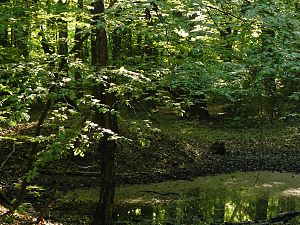Braken and Harselah
|
Braken and Harselah
|
||
|
Typical depression with waterlogging in the Braken natural forest |
||
| location | South of Harsefeld , Stade district , Lower Saxony | |
| surface | 583 ha | |
| Identifier | NSG LÜ 175 | |
| WDPA ID | 162524 | |
| Geographical location | 53 ° 25 ' N , 9 ° 30' E | |
|
|
||
| Sea level | from 40 m to 48 m | |
| Setup date | September 16, 1989 | |
| administration | NLWKN | |
| particularities | On about 96 ha overlay with the Braken natural forest | |
Braken and Harselah is a nature reserve in the Flecken Harsefeld and the municipality of Ahlerstedt in the combined municipality of Harsefeld in the district of Stade .
The nature reserve with the sign NSG LÜ 175 is about 583 hectares . Almost all of it is designated as the FFH area “Braken”, which extends over 639 hectares. 95.9 hectares are designated as natural forest . The area has been under protection since September 16, 1989. The responsible lower nature conservation authority is the district of Stade.
The nature reserve, which consists of four sub-areas, is located south of Harsefeld. It places the " Braken " forest on a historically old forest site in the north and parts of the "Harselah" forest in the south under protection. Both areas are linked by the nature reserve " Kahles and Wildes Moor ". The "Kahle und Wilde Moor" was part of the nature reserve, which was then still designated as "Braken, Harselah, Kahles and Wildes Moor" until February 2017, before it was designated as a separate nature reserve. The nature protection ordinance for the nature reserve “Braken and Harselah” was subsequently revised and came into force on December 14, 2018. To the east of the “Braken” sub-area, there are two more, predominantly forested areas that are part of the nature reserve. In the course of the new version of the Protected Area Ordinance, two sub-areas, which were previously also separated from the rest of the nature reserve, were connected to it by expanding the area.
The nature reserve is largely occupied by forest areas on a Geest hill of the Zevener Geest . As forest communities are oak-hornbeam forest , Hainsimsen- Buchenwald , Woodruff-beech forest and acidic beech forest on predominantly congestion damp to waterlogged and partly to find periodically wet locations. Most of the forest communities are close to nature. They have a high proportion of old and dead wood . In the herb layer settle u. a. Wood jerks , lily of the valley , liverwort , woodruff , single berry , dark lungwort , wood sanicle as well as greenish and white wood hyacinths . There are also king ferns and marsh marigolds . Forest edges and fringes are taken up by tall herbaceous corridors . A total of around 220 plant species live in the nature reserve, over 30 of which are on the red list .
Over 300 species of mushrooms are represented, over 40 of which are on the red list. A specialty is the occurrence of the dead wood fungus Ästiger Stachelbart .
The nature reserve is the habitat of a species-rich fauna . More than 70 breeding bird species are native here and numerous guest bird species can be found here. The nature reserve is a habitat and a. for stock pigeon , black and middle woodpecker , black stork , goat milker , golden cockerel, chaffinch , fitis , nuthatch and nightingale . Amphibians and reptiles are represented by around ten species, including crested newt , mountain newt , tree frog and fire salamander . The forest areas provide a habitat for four bat species . Insects are particularly rich in species . Various parasitic wasps , longhorn and bark beetles , ants and wild bees can be found in the nature reserve . Butterflies are represented with over 30 species. A beetle mapping in the 1990s identified over 700 species. A specialty is the mud swimmer, which has been detected in the Braken pools and has its northernmost known occurrence here. Furthermore, the forest areas offer a habitat for numerous mites , spiders and millipedes .
Faces were in the past with coniferous trees , including Japanese larch , spruce and Douglas fir , reforested . In the long term, the coniferous forests are to be converted back into natural deciduous forest communities.
Several brooks arise in the Braken, including the Brakengraben. In stream valleys, alluvial forests are covered with alder and ash . In the edge areas of the Braken, grassland is included in the nature reserve. Small areas of grassland can also be found within the Braken.
The nature reserve is also used for local recreation. Several forest trails run through Braken and Harselah . The Mönchsweg runs through the Braken. Several erratic boulders in the Braken are designated as natural monuments (→ List of natural monuments in the Stade district ).
Web links
- Nature reserve "Braken und Harselah" in the database of the Lower Saxony State Office for Water Management, Coastal and Nature Conservation (NLWKN)
- Braken natural forest - a habitat with history , leaflet from the district of Stade (PDF file, 1.5 MB)
Individual evidence
- ↑ Braken , profiles of the Natura 2000 areas, Federal Agency for Nature Conservation . Retrieved January 17, 2019.
- ↑ Profile of the Braken natural forest , database of natural forest reserves in Germany, Federal Agency for Agriculture and Food . Retrieved July 14, 2017.
- ^ Ordinance on the nature reserve “Braken and Harselah” , district of Stade. Retrieved January 17, 2019.
- ↑ Zeven to Harsefeld , Mönchsweg. Retrieved January 17, 2019.



